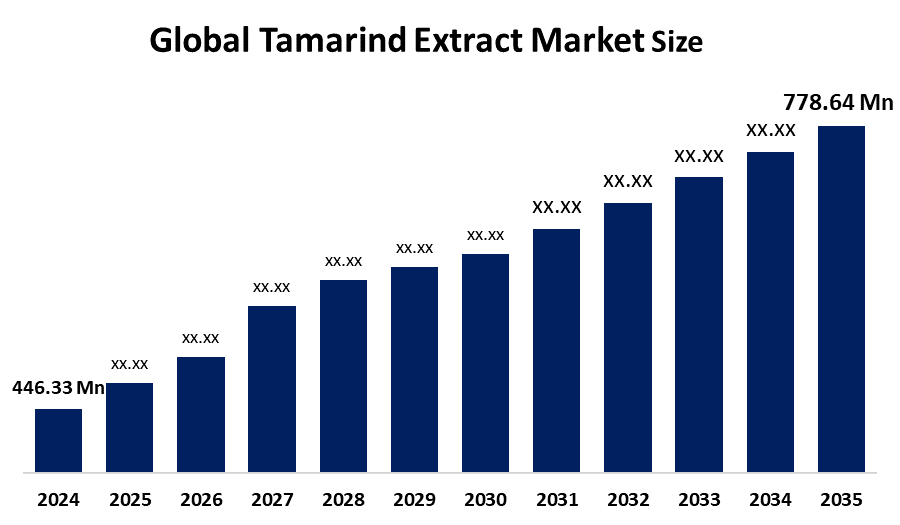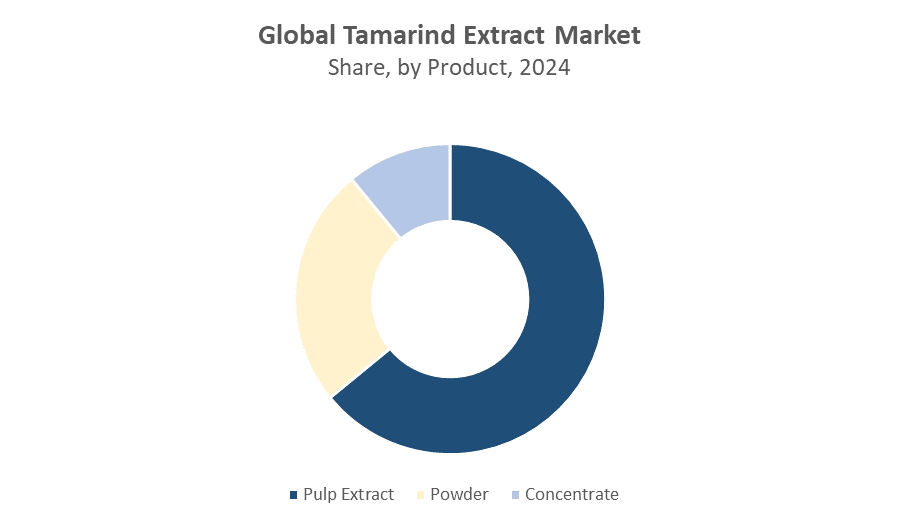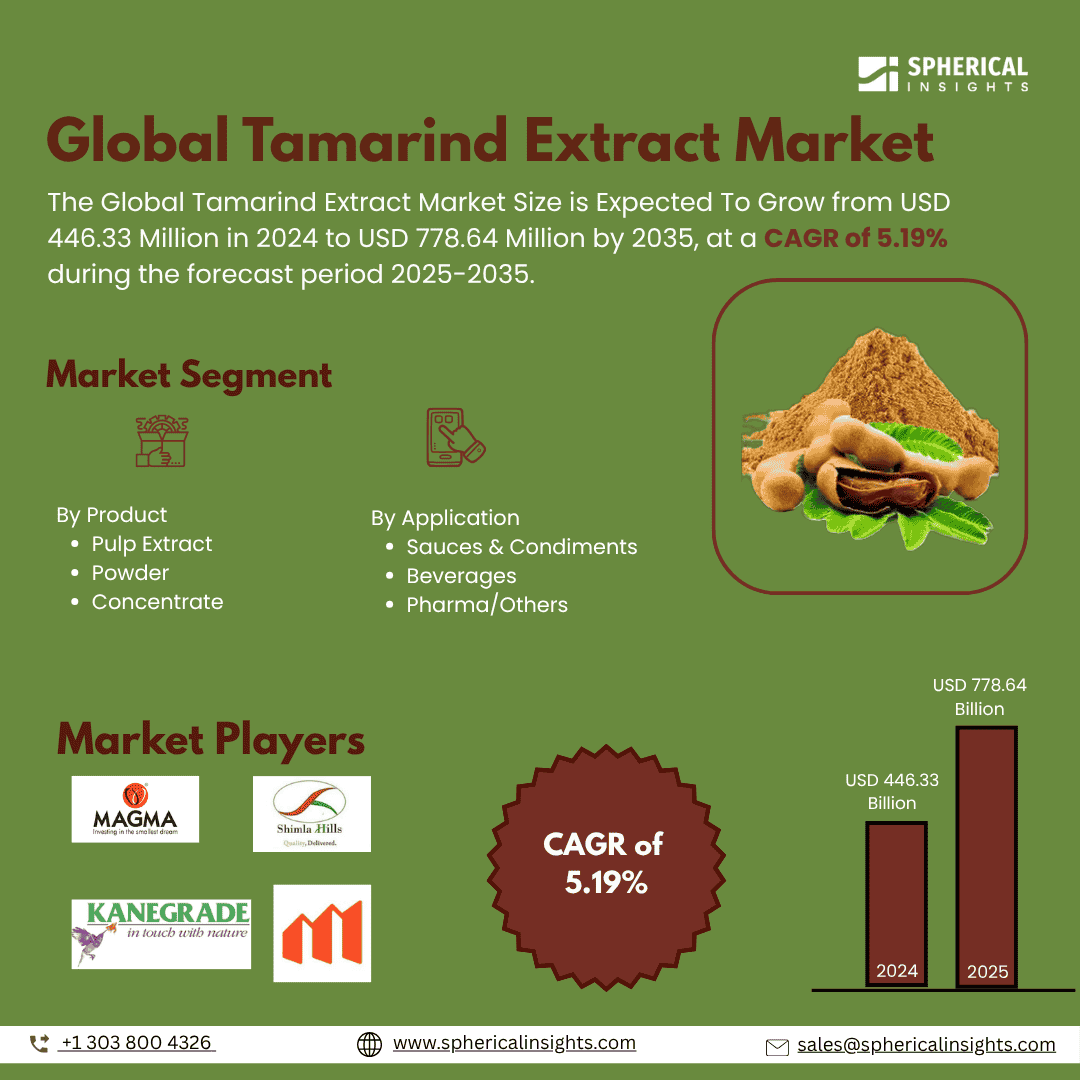Tamarind Extract Market Summary, Size & Emerging Trends
According to Decision Advisor, The Global Tamarind Extract Market Size is Expected To Grow from USD 446.33 Million in 2024 to USD 778.64 Million by 2035, at a CAGR of 5.19% during the forecast period 2025-2035. Increasing demand for natural flavors and functional ingredients in food, beverages, and pharmaceutical products is a key driving factor for the tamarind extract market.

Key Market Insights
- Asia Pacific is expected to account for the largest share in the tamarind extract market size during the forecast period.
- In terms of product type, the pulp extract segment dominated in terms of revenue during the forecast period.
- In terms of application, the sauces & condiments segment accounted for the largest revenue share in the global tamarind extract market size during the forecast period.
Global Market Forecast and Revenue Outlook
- 2024 Market Size: USD 446.33 Million
- 2035 Projected Market Size: USD 778.64 Million
- CAGR (2025-2035): 5.19%
- Asia Pacific: Largest market in 2024
- North America: Fastest growing market

Tamarind Extract Market
The Tamarind Extract Market Size revolves around producing extracts from tamarind pulp, powder, and concentrate, primarily used as flavoring agents, preservatives, and functional ingredients. These extracts enhance taste, provide natural acidity, and offer antioxidant benefits, making them valuable in sauces, condiments, beverages, and pharmaceutical products. Key producing regions support the market through agricultural programs, export incentives, and stringent quality standards, ensuring consistent supply and high product quality. Rising consumer awareness and preference for natural, clean-label ingredients further drive demand, particularly in food and beverage innovation. Additionally, the extract’s versatility in improving flavor profiles and nutritional value positions it as a critical component in processed foods, functional beverages, and nutraceuticals. Overall, the market growth is fueled by health-conscious consumption patterns and increasing applications across multiple industries.
Tamarind Extract Market Trends
- Increasing preference for natural and plant-based ingredients in the food and beverage industry.
- Growing adoption in functional foods and nutraceuticals due to antioxidant and digestive health benefits.
- Companies are investing in sustainable sourcing and processing technologies to enhance product quality and reduce environmental impact.
Tamarind Extract Market Dynamics
Driving Factors: Growing demand for natural flavoring and functional ingredients
The tamarind extract market is propelled by increasing consumer health consciousness and the preference for natural, clean-label food products. Tamarind extract’s multifunctional properties as a natural flavoring, preservative, and functional ingredient have expanded its applications in beverages, sauces, condiments, and pharmaceuticals. Growth in the global foodservice, processed food, and beverage industries further fuels demand. Government initiatives promoting sustainable agriculture practices in key producing regions ensure a reliable supply of high-quality tamarind, supporting continuous market expansion. Additionally, the trend toward plant-based and functional ingredients in food innovation highlights tamarind extract as a versatile and attractive solution for manufacturers.
Restrain Factors: Availability of synthetic substitutes and regional supply limitations
Market growth faces challenges from synthetic flavorings and acids, which often provide cost advantages and consistent supply. Tamarind production is heavily dependent on specific growing regions, making it susceptible to seasonal fluctuations and climate conditions, which can disrupt raw material availability. Moreover, the high costs associated with processing, quality assurance, and compliance can create barriers for smaller manufacturers, limiting their ability to compete effectively and expand market presence.
Opportunity: Expansion in nutraceuticals and functional foods
Tamarind extract offers significant growth potential in functional foods, beverages, and nutraceuticals due to its recognized health benefits, including antioxidant activity, digestive support, and anti-inflammatory effects. Rising consumer awareness of these benefits drives adoption in pharmaceutical and wellness products. Furthermore, the expanding processed food and beverage markets in emerging economies, combined with growing demand in Western countries for natural flavor enhancers, present strategic opportunities for manufacturers to diversify applications and reach new markets.
Challenges: Supply chain and quality standard compliance
Maintaining consistent quality and purity across global supply chains remains a critical challenge for the tamarind extract market. The limited cultivation regions and climate-dependent production can lead to fluctuations in both supply and pricing. In addition, adherence to strict international quality and safety standards for food and pharmaceutical ingredients requires ongoing monitoring and investment, which can pose difficulties for small and mid-sized producers. These challenges emphasize the need for robust supply chain management and efficient production practices to sustain growth in the market.
Global Tamarind Extract Market Ecosystem Analysis
The global tamarind extract market ecosystem includes key players such as raw tamarind suppliers, extract manufacturers, and end-users in food, beverage, and pharmaceutical industries. Suppliers, especially in India, Thailand, and Indonesia, influence raw material availability and pricing. Manufacturers focus on refining extraction processes, improving purity, and expanding applications. Regulatory bodies enforce quality and safety standards, ensuring safe and consistent products. This ecosystem’s growth relies on sustainable sourcing, technological innovation, and adherence to global standards, driving market expansion worldwide.
Global Tamarind Extract Market, By Product
The pulp extract segment dominates the tamarind extract market in terms of revenue, accounting for approximately 60% of the global market share. Its dominance is attributed to its extensive use in traditional and processed food products, including sauces, condiments, chutneys, and ready-to-eat meals. Tamarind pulp extract is valued for its natural tangy flavor, acidity, and functional benefits, such as antioxidant properties and digestive support. These qualities make it a preferred choice for food manufacturers seeking to enhance taste profiles while maintaining clean-label and natural ingredient credentials. The widespread culinary adoption across Asia, Africa, and Latin America further reinforces its leading position in the market.

The powdered tamarind segment holds an estimated 30% of the market share, driven by its convenience, longer shelf life, and ease of handling. Tamarind powder is widely used in spice blends, sauces, beverages, and functional drinks, providing consistent flavor intensity and easy incorporation into recipes. Its transportability and storage advantages make it particularly attractive for large-scale food processing and export markets. Additionally, powdered tamarind allows precise dosage in pharmaceutical and nutraceutical applications, expanding its adoption in health-oriented products. The segment’s growth is expected to continue as demand for ready-to-use, natural, and functional ingredients rises globally.
Global Tamarind Extract Market, By Application
The sauces and condiments segment dominate the tamarind extract market, accounting for approximately 50% of global revenue. This leadership is driven by the widespread use of tamarind extract in ketchups, chutneys, marinades, and salad dressings. Tamarind’s natural tanginess, flavor-enhancing properties, and functional benefits such as antioxidant activity make it a preferred choice for manufacturers seeking clean-label and natural ingredients. The global popularity of ethnic cuisines and the growing demand for traditional taste profiles in processed foods further reinforce its dominant market position. Additionally, expanding foodservice and retail sectors, particularly in Asia-Pacific and Latin America, contribute significantly to the consistent demand for tamarind extract in sauces and condiments.
The beverage segment holds an estimated 20% of the market share, reflecting increasing adoption in functional, flavored, and traditional drinks. Tamarind extract is widely incorporated into health drinks, juices, iced teas, and traditional tamarind beverages due to its natural acidity, refreshing taste, and health benefits, including digestive support and antioxidant properties. Rising consumer preference for natural, clean-label beverages, along with the expansion of ready-to-drink and functional beverage categories, is driving demand. The segment’s growth is particularly strong in emerging economies and regions with established tamarind beverage traditions, offering manufacturers significant opportunities for product innovation and market expansion.
Asia Pacific holds the largest share of the tamarind extract market, primarily due to extensive production in India, Thailand, and Indonesia. These countries benefit from favorable climatic conditions and established agricultural practices for tamarind cultivation. The region also experiences strong demand from food and beverage industries, particularly for sauces, condiments, and traditional beverages, which drives consistent consumption of tamarind extract. Rapid urbanization, growing processed food sectors, and expanding export activities further reinforce Asia Pacific’s market dominance.
India is witnessing robust market growth, with a projected CAGR of around 10% during the forecast period. This growth is fueled by rising domestic consumption and increasing export demand for tamarind extract. The southern regions, especially Tamil Nadu and Andhra Pradesh, serve as major production hubs, contributing significantly to both local and international supply chains. Government support for sustainable agriculture and quality standard enforcement strengthens India’s position in the global market.
North America is emerging as the fastest-growing market, driven by increasing adoption of clean-label foods, nutraceuticals, and functional beverages. The U.S. market is expanding rapidly due to rising consumer preference for natural flavors and plant-based ingredients. Growth in health-conscious and specialty food sectors, along with technological advancements in processing and distribution, is accelerating tamarind extract adoption across the region.
WORLDWIDE TOP KEY PLAYERS IN THE TAMARIND EXTRACT MARKET INCLUDE
- Magma Foods Private Limited
- Kanegrade Limited
- Shimla Hills
- MoonLite
- Xi’an Victory Biochemical Technology Co., Ltd.
- ABC International
- Baaeco V Food Ltd.
- Jadli Foods (India) Pvt. Ltd.
- Abdullabhai Abdul Kader
- Revata Food Products Pvt. Ltd.
- Others
-
Product Launches in Tamarind Extract Market
- In March 2024, Kancor Ingredients introduced a new line of organic tamarind pulp extract, aimed specifically at nutraceutical and functional beverage manufacturers in North America and Europe. This launch highlights the growing trend of incorporating natural and clean-label ingredients into health-oriented products. The organic extract offers enhanced quality, purity, and consistent flavor, meeting the stringent regulatory standards of Western markets. By targeting nutraceuticals and functional beverages, Kancor Ingredients is capitalizing on the rising consumer demand for antioxidant-rich, digestive-friendly, and plant-based ingredients. This strategic expansion strengthens the company’s global presence and aligns with the broader industry shift toward sustainable, health-focused food and beverage solutions.
Market Segment
This study forecasts revenue at global, regional, and country levels from 2020 to 2035. Decision Advisor has segmented the tamarind extract market based on the below-mentioned segments:
Global Tamarind Extract Market, By Product
- Pulp Extract
- Powder
- Concentrate
Global Tamarind Extract Market, By Application
- Sauces & Condiments
- Beverages
- Pharma/Others
Global Tamarind Extract Market, By Regional Analysis
- North America
- Europe
- Germany
- UK
- France
- Italy
- Spain
- Russia
- Rest of Europe
- Asia Pacific
- China
- Japan
- India
- South Korea
- Australia
- Rest of Asia Pacific
- South America
- Brazil
- Argentina
- Rest of South America
- Middle East & Africa
- UAE
- Saudi Arabia
- Qatar
- South Africa
- Rest of the Middle East & Africa
FAQs
Q: What are the main drivers of growth in the Tamarind Extract market?
A: Key growth drivers include rising demand for natural flavoring and functional ingredients, increasing consumer health consciousness, and growing applications in sauces, beverages, and nutraceutical products.
Q: What challenges are limiting the adoption of Tamarind Extract products?
A: Challenges include availability of synthetic substitutes, climate-dependent supply fluctuations, high processing costs, and compliance with stringent quality and safety standards.
Q: What opportunities exist in the Tamarind Extract market?
A: Expanding applications in functional foods, nutraceuticals, and beverages, along with rising consumer awareness of antioxidant and digestive health benefits, present significant growth opportunities.
Q: Which trends are currently shaping the Tamarind Extract market?
A: Increasing preference for plant-based ingredients, adoption in functional foods and nutraceuticals, and investment in sustainable sourcing and processing technologies are key trends.
Q: How does India contribute to the Tamarind Extract market?
A: India is witnessing robust growth with a projected CAGR of 10%, driven by domestic consumption, export demand, and production hubs in Tamil Nadu and Andhra Pradesh.
Q: What applications make Tamarind Extract a versatile ingredient?
A: Tamarind extract serves as a natural flavoring, preservative, and functional ingredient, enhancing taste, acidity, antioxidant content, and digestive benefits in sauces, beverages, and pharmaceuticals.
Q: What is the long-term outlook (2025–2035) for the Tamarind Extract market?
A: The market is expected to continue growing steadily, supported by health-conscious consumption patterns, expansion into functional foods and beverages, and increased adoption in nutraceutical and clean-label products.





